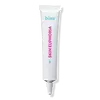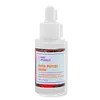What's inside
What's inside
 Key Ingredients
Key Ingredients

 Benefits
Benefits

 Concerns
Concerns

No concerns
 Ingredients Side-by-side
Ingredients Side-by-side

Water
Skin ConditioningSalix Alba Bark Water
AstringentSqualane
EmollientPropanediol
SolventSodium Potassium Aluminum Silicate
Niacinamide
SmoothingDiglycerin
HumectantTocopherol
AntioxidantSodium Hyaluronate
HumectantBakuchiol
AntimicrobialAzelaic Acid
BufferingAvena Sativa Kernel Extract
AbrasiveEpilobium Angustifolium Flower/Leaf/Stem Extract
Skin ConditioningPalmitoyl Tripeptide-5
Skin ConditioningPalmitoyl Tripeptide-38
Skin ConditioningAcetyl Hexapeptide-8
HumectantHexapeptide-9
Skin ConditioningLactic Acid
BufferingGlycerin
HumectantLactobacillus/Pumpkin Fruit Ferment Filtrate
Skin ConditioningCetearyl Olivate
Ceramide Ng
Skin ConditioningTridecyl Trimellitate
EmollientSaccharide Isomerate
HumectantCaprylyl Glycol
EmollientHydroxypropyl Cyclodextrin
MaskingUndecane
EmollientTridecane
PerfumingTridecyl Stearate
EmollientNeopentyl Glycol Dicaprylate/Dicaprate
EmollientPolyacrylate Crosspolymer-6
Emulsion StabilisingHydroxyethyl Acrylate/Sodium Acryloyldimethyl Taurate Copolymer
Emulsion StabilisingSorbitan Olivate
EmulsifyingSorbitan Isostearate
EmulsifyingPolysorbate 60
EmulsifyingC14-22 Alcohols
Emulsion StabilisingC12-20 Alkyl Glucoside
EmulsifyingSilica
AbrasiveHexylene Glycol
EmulsifyingButylene Glycol
HumectantSodium Citrate
BufferingSodium Phytate
Tetrasodium Glutamate Diacetate
Trisodium Ethylenediamine Disuccinate
Sodium Metabisulfite
AntioxidantPhenoxyethanol
PreservativeEthylhexylglycerin
Skin ConditioningPotassium Sorbate
PreservativeLeuconostoc/Radish Root Ferment Filtrate
AntimicrobialCitric Acid
BufferingCI 77891
Cosmetic ColorantWater, Salix Alba Bark Water, Squalane, Propanediol, Sodium Potassium Aluminum Silicate, Niacinamide, Diglycerin, Tocopherol, Sodium Hyaluronate, Bakuchiol, Azelaic Acid, Avena Sativa Kernel Extract, Epilobium Angustifolium Flower/Leaf/Stem Extract, Palmitoyl Tripeptide-5, Palmitoyl Tripeptide-38, Acetyl Hexapeptide-8, Hexapeptide-9, Lactic Acid, Glycerin, Lactobacillus/Pumpkin Fruit Ferment Filtrate, Cetearyl Olivate, Ceramide Ng, Tridecyl Trimellitate, Saccharide Isomerate, Caprylyl Glycol, Hydroxypropyl Cyclodextrin, Undecane, Tridecane, Tridecyl Stearate, Neopentyl Glycol Dicaprylate/Dicaprate, Polyacrylate Crosspolymer-6, Hydroxyethyl Acrylate/Sodium Acryloyldimethyl Taurate Copolymer, Sorbitan Olivate, Sorbitan Isostearate, Polysorbate 60, C14-22 Alcohols, C12-20 Alkyl Glucoside, Silica, Hexylene Glycol, Butylene Glycol, Sodium Citrate, Sodium Phytate, Tetrasodium Glutamate Diacetate, Trisodium Ethylenediamine Disuccinate, Sodium Metabisulfite, Phenoxyethanol, Ethylhexylglycerin, Potassium Sorbate, Leuconostoc/Radish Root Ferment Filtrate, Citric Acid, CI 77891
Water
Skin ConditioningPropanediol
SolventGlycerin
HumectantAmmonium Acryloyldimethyltaurate/Vp Copolymer
1,2-Hexanediol
Skin ConditioningDiheptyl Succinate
EmollientCapryloyl Glycerin/Sebacic Acid Copolymer
Skin ConditioningGlycine
BufferingXanthan Gum
EmulsifyingEthylhexylglycerin
Skin ConditioningCaprylyl Glycol
EmollientAcetyl Hexapeptide-8
HumectantAcetyl Octapeptide-3
HumectantSodium Hyaluronate
HumectantCopper Tripeptide-1
Skin ConditioningTocopherol
AntioxidantWater, Propanediol, Glycerin, Ammonium Acryloyldimethyltaurate/Vp Copolymer, 1,2-Hexanediol, Diheptyl Succinate, Capryloyl Glycerin/Sebacic Acid Copolymer, Glycine, Xanthan Gum, Ethylhexylglycerin, Caprylyl Glycol, Acetyl Hexapeptide-8, Acetyl Octapeptide-3, Sodium Hyaluronate, Copper Tripeptide-1, Tocopherol
 Reviews
Reviews

Ingredients Explained
These ingredients are found in both products.
Ingredients higher up in an ingredient list are typically present in a larger amount.
Acetyl Hexapeptide-8, commonly known as Argireline or Acetyl Hexapeptide-3, is a popular peptide in skincare. It’s often referred to as a “Botox-like” ingredient because it helps reduce muscle movement.
By relaxing these micro-movements, Argireline may help minimize the appearance of fine lines and wrinkles. That said, it’s not as powerful as Botox, and research on its long-term effectiveness is still limited.
Beyond smoothing, Argireline may also support collagen production. Collagen is the protein that helps keep your skin firm, bouncy, and well-hydrated by strengthening the skin barrier.
So while Argireline isn’t a miracle fix, it can be a helpful addition to a routine focused on both prevention and skin health.
Read more about other common types of peptides here:
Learn more about Acetyl Hexapeptide-8Caprylyl Glycol is a humectant and emollient, meaning it attracts and preserves moisture.
It is a common ingredient in many products, especially those designed to hydrate skin. The primary benefits are retaining moisture, skin softening, and promoting a healthy skin barrier.
Though Caprylyl Glycol is an alcohol derived from fatty acids, it is not the kind that can dry out skin.
This ingredient is also used as a preservative to extend the life of products. It has slight antimicrobial properties.
Learn more about Caprylyl GlycolEthylhexylglycerin (we can't pronounce this either) is commonly used as a preservative and skin softener. It is derived from glyceryl.
You might see Ethylhexylglycerin often paired with other preservatives such as phenoxyethanol. Ethylhexylglycerin has been found to increase the effectiveness of these other preservatives.
Glycerin is already naturally found in your skin. It helps moisturize and protect your skin.
A study from 2016 found glycerin to be more effective as a humectant than AHAs and hyaluronic acid.
As a humectant, it helps the skin stay hydrated by pulling moisture to your skin. The low molecular weight of glycerin allows it to pull moisture into the deeper layers of your skin.
Hydrated skin improves your skin barrier; Your skin barrier helps protect against irritants and bacteria.
Glycerin has also been found to have antimicrobial and antiviral properties. Due to these properties, glycerin is often used in wound and burn treatments.
In cosmetics, glycerin is usually derived from plants such as soybean or palm. However, it can also be sourced from animals, such as tallow or animal fat.
This ingredient is organic, colorless, odorless, and non-toxic.
Glycerin is the name for this ingredient in American English. British English uses Glycerol/Glycerine.
Learn more about GlycerinPropanediol is an all-star ingredient. It softens, hydrates, and smooths the skin.
It’s often used to:
Propanediol is not likely to cause sensitivity and considered safe to use. It is derived from corn or petroleum with a clear color and no scent.
Learn more about PropanediolSodium Hyaluronate is hyaluronic acid's salt form. It is commonly derived from the sodium salt of hyaluronic acid.
Like hyaluronic acid, it is great at holding water and acts as a humectant. This makes it a great skin hydrating ingredient.
Sodium Hyaluronate is naturally occurring in our bodies and is mostly found in eye fluid and joints.
These are some other common types of Hyaluronic Acid:
Learn more about Sodium HyaluronateTocopherol (also known as Vitamin E) is a common antioxidant used to help protect the skin from free-radicals and strengthen the skin barrier. It's also fat soluble - this means our skin is great at absorbing it.
Vitamin E also helps keep your natural skin lipids healthy. Your lipid skin barrier naturally consists of lipids, ceramides, and fatty acids. Vitamin E offers extra protection for your skin’s lipid barrier, keeping your skin healthy and nourished.
Another benefit is a bit of UV protection. Vitamin E helps reduce the damage caused by UVB rays. (It should not replace your sunscreen). Combining it with Vitamin C can decrease sunburned cells and hyperpigmentation after UV exposure.
You might have noticed Vitamin E + C often paired together. This is because it is great at stabilizing Vitamin C. Using the two together helps increase the effectiveness of both ingredients.
There are often claims that Vitamin E can reduce/prevent scarring, but these claims haven't been confirmed by scientific research.
Learn more about TocopherolWater. It's the most common cosmetic ingredient of all. You'll usually see it at the top of ingredient lists, meaning that it makes up the largest part of the product.
So why is it so popular? Water most often acts as a solvent - this means that it helps dissolve other ingredients into the formulation.
You'll also recognize water as that liquid we all need to stay alive. If you see this, drink a glass of water. Stay hydrated!
Learn more about Water